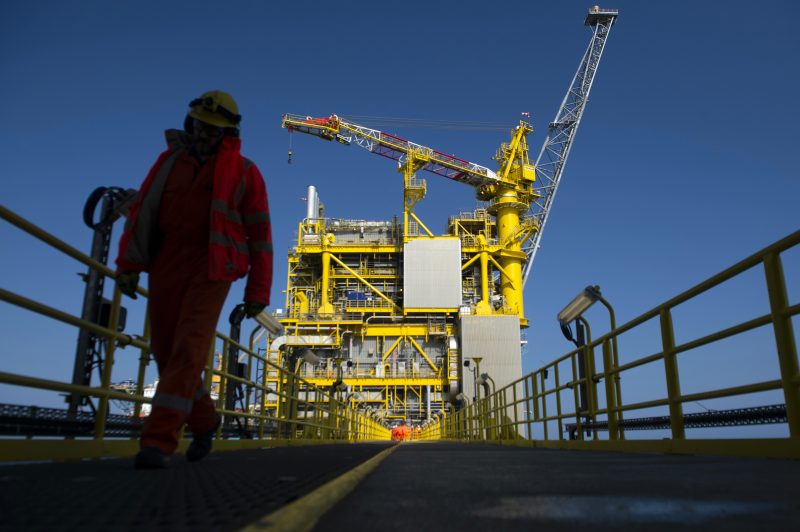Total gears up for North Sea gas hunt
French oil major Total is set to drill for natural gas in the Culzean field, deep below the cold waters of the North Sea (ANDY BUCHANAN)
ABOARD CULZEAN PLATFORM, NORTH SEA (United Kingdom) (AFP) – Deep beneath the cold waters of the North Sea lies what French energy giant Total hopes will help feed Britain’s voracious appetite for gas.
Total forecasts that the Culzean field, located more than 15,000 metres under the seabed halfway between Scotland and Norway, will cover five percent of Britain’s gas requirements.
“There’s still life” in North Sea production despite its dwindling energy reserves, Total’s Culzean project manager Claus Vissing-Jorgensen told AFP on a recent trip to the Culzean site before drilling begins in the coming days.
Accessible by helicopter, Culzean is about 45 miles (70 kilometres) east of the Aberdeen, Europe’s self-proclaimed oil capital on Scotland’s northeast coast.
It comprises three vast and bright yellow platforms, one of which is a structure that runs all the way to the seabed and contains drilling equipment.
The other two are used for refining and living quarters for 180 people.
The seabed lies 90 metres (yards) below the platforms, but drilling continues for another 15,000 metres below that.
The gigantic platforms sprout from the sea almost like giant multi-storey buildings but with dark waves of water lapping at their foundations in strong winds.
Paris-based Total, which took over Culzean with a $7.5-billion purchase of the oil and gas exploration arm of Danish giant Maersk in 2017, is expected to drill for so-called “First Gass” soon.
Total has a 49.99-percent share of the Culzean field, with the rest owned by partners BP and Japan’s JX Nippon.
If and when Culzean reaches optimum output by the end of 2020, Total says it will produce around 18 percent of Britain’s total gas needs.
On Friday, the International Energy Agency (IEA) said that 2018 was a “golden year” for natural gas with global demand soaring, but environment and energy sector analysts say the gas boom could have dire effects on Earth’s climate, as warnings of the need to slash fossil fuel use grow ever stronger.
– Revival –
Meanwhile, independent experts agree that the North Sea still had much gas left.
“We have seen quite an increase in production — a 20-percent increase in (oil and gas) production over the past five years — which is really quite remarkable for a mature basin,” said Professor Paul de Leeuw, head of the Oil and Gas Institute at Robert Gordon University in Aberdeen.
He added that the “revival” of North Sea output was also the result of an improved UK corporate tax environment.
Authorities are keen to encourage more production in the North Sea basin, where operations support about 280,000 jobs both directly and indirectly according to industry organisation Oil & Gas UK.
That number is nonetheless half the amount of jobs provided during the industry’s peak in 2014.
In addition, around half of the North Sea’s precious energy reserves have already been extracted, according to industry estimates, making it one of the world’s most mature basins.
Meanwhile despite a sizeable rebound in UK North Sea production over the last five years, current output remains far from peak levels enjoyed in the 1990s and 2000s, when it regularly topped 5.0 million barrels of oil and gas per day.
It stood at only 1.7 million barrels of oil equivalent per day (oepd) in 2018 and the amount is set to decline further, according to the Oil & Gas Authority regulator.
Total wants Culzean’s gas production to reach between 60,000-90,000 barrels oepd by 2021 for a lifespan of at least 13 years.
The company’s overall budget for the project stands at $4.0 billion.
In recent years however, US energy major ConocoPhillips and Anglo-Dutch group Shell have sold off North Sea oil and gas assets.
Disclaimer: Validity of the above story is for 7 Days from original date of publishing. Source: AFP.


